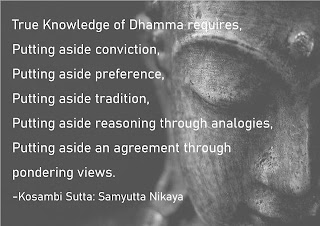Discerning as against Logical Reasoning in understanding Buddha Dhamma
It is said that the dhamma preached by the Buddha is athakkavacara, meaning beyond the scope of logic.
Through logical reasoning one finds that he (or she) is right; Through discernment (vicakshana) one finds that he is wrong!
Buddha Dhamma is about discerning (vicakshana) and not about logical reasoning (tarka). Discerning and logical reasoning are two different things which contradict each other. We need to understand that first, i.e., what logic is and what discerning is.
Discerning (of the dhamma) awaken yonisomanasikara known as the wise attention or more precisely, radical attention. Few other Pali terms with similar meanings are upa parikshanaya , parivimansana and patikucca vinita.
"Why would logical reasoning become important?
Isn't it to affirm that 'I' know what is right and to reaffirm that that 'I' am right? "
Logical reasoning relies upon sadda (faith) ruci (preference) anusrava (knowledge by listening) akara-parivitakka (reasoned contemplation) and ditti nijjana khanti (as it agrees with one's view).
Reliance on these five affirms that one knows and that one is right (according to what one hears, as one thinks, as for one's preference, according to his or her knowledge gained by listening and one's own view) and makes one to hold on to what one knows as right. Buddha dhamma is to be understood through discerning and not through logical reasoning!
When one follows dhamma, one must develop yonisomanasikara that paves the way to samma ditti (the right view). One can develop yonisomanasikara when the person hears dhamma from a salutary friend (kalyana mitta) which directs him or her to gain the right view.
In a sutra that we find in Anguttara Nikaya, the Buddha preaches us about patikucca vinita, which means earning discipline (hikmima) by way of questioning. Take for instance, when we hear the dhamma that penetrates the truth, if we seem to understand what is said just by listening to it, that's often due to us relating it to something that we already know.
There are things that we already know in Buddha's teachings, they are things that are perceptive to the mundane right view . The worldly view is the mundane right view or the lowkika samma ditti. There are things that are perceptive to this mundane right view. When the Buddha teaches dhamma that is perceptive to the mundane right view, we understand it, because that is where we are now. The Path is to develop the supramundane right view or the lokottara samma ditti for the one who has the mundane right view.
"Think carefully about what I say. The one who is with the mundane right view needs to listen to a dhamma that opens up the Path which can awaken the supramundane right view."
As we are within the frame of the mundane right view the dhamma we need to hear should bring about a shift in our view which transcends the mundane view, if not we will simply understand what is heard, processed through our existing standpoint and therefore we would not endeavour to search beyond. We will only understand what appeals to the mundane right view we have now.
Therefore, we need to hear a dhamma that awakens yonisomanasikara to develop the supermundane right view. When there is something that is not clearly manifested one needs to search with questioning, i.e. search through questioning, known as paticucca vinita in Pali, awakens yonisomanasikara.
When one hears a dhamma that cannot be understood through one's own standpoint, the person recognises his weakness and begins to search with questioning, to awaken his realisation.
As what the person hears doesn't agree with what he or she knows, the person begins to concentrate on developing radical attention (yonisomanasikara) in order to comprehend that specific dhamma. The person attempts to understand through discernment as it did not meet his or her own frame of mind.
If what was preached by the Buddha was what we already know, we do not need to listen to his dhamma, if we knew the truth we won't be in samsara for this long.
Buddha preached a dhamma that is to be understood and seen free of sadda, ruci, anusrava, akara-parivitakka, ditti nijjana khanti (Kosambi Sutra-SN). Therefore, one needs yonisomanasikara developed through discernment.
Logical reasoning is to justify what we already know as the truth. Discerning comes into play when we know that what we know is incorrect.
The supramundane right view is gained by abandoning the self-view or sakkaya ditti.
"What is meant as abandoning the self view?
It is when we find the error in taking as I."
"When we hear a dhamma, if we find that I am right, and that it conforms to what I know, will it relinquish the self view?, or will it boost it? it certainly will nourish and grow the self view."
Radical attention arises by understanding that I am wrong, logical reasoning justify that I am right and what 'I' know is right. The result or the effect of discerning (vithakshana) and search through questioning (paticucca vinita) is realisation of the error in taking as I which leads to abandoning the self view.
If we do not follow what the Buddha has already preached to gain this realisation, we cannot end this samsaric journey.
This short sermon is to clarify that while the logical reasoning or tarka justifies one's position in taking as I, on the other hand, through discerning one recognises the error in taking as I, making him or her to concentrate on abandoning the self view.
As said at the beginning, the Buddha dhamma is to be considered as a dhamma beyond the scope of logic that takes one along the path to abandon the Self view.
- Venerable Alawwe Anomadassi Thero




Comments
Post a Comment